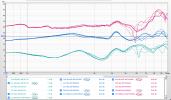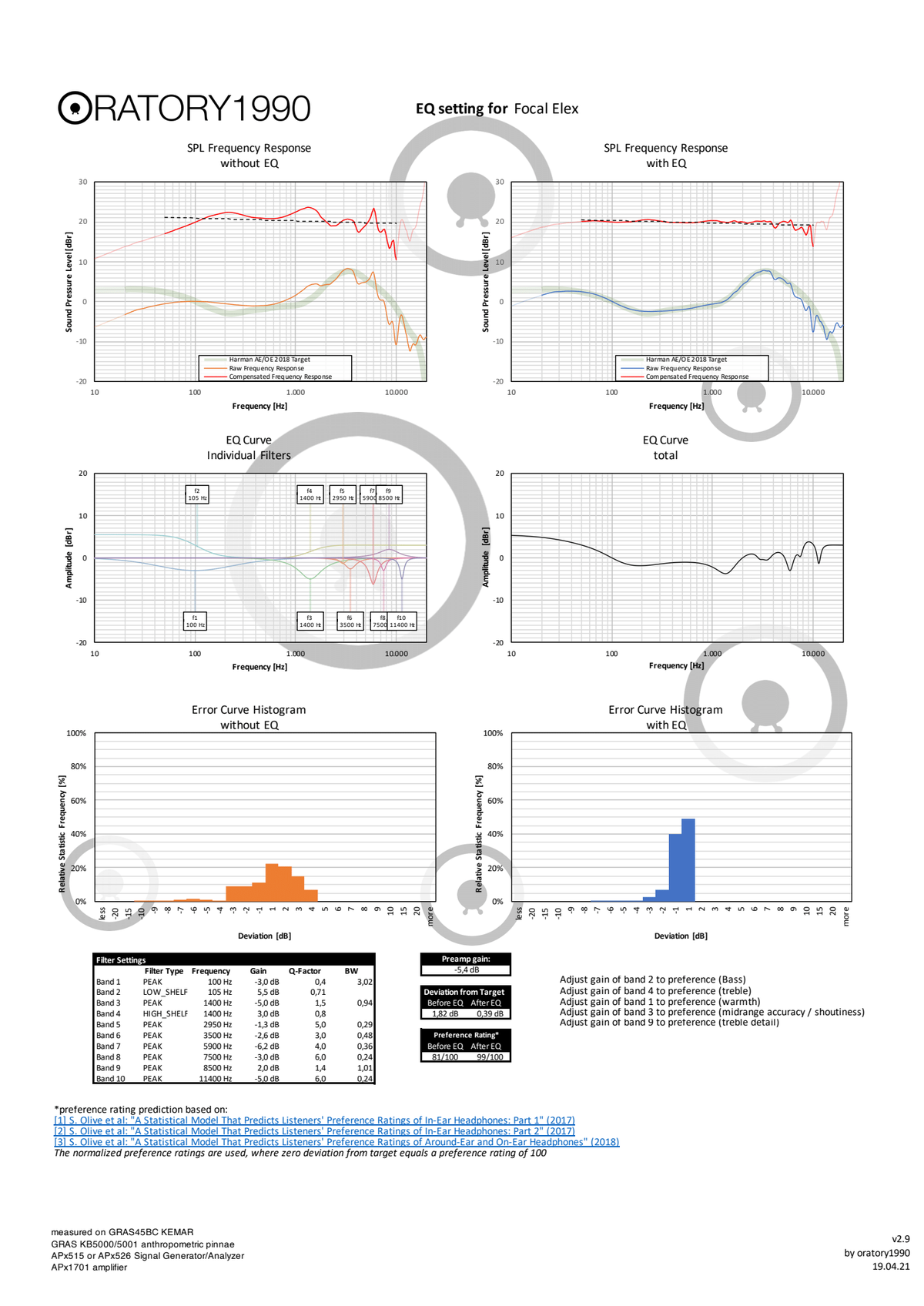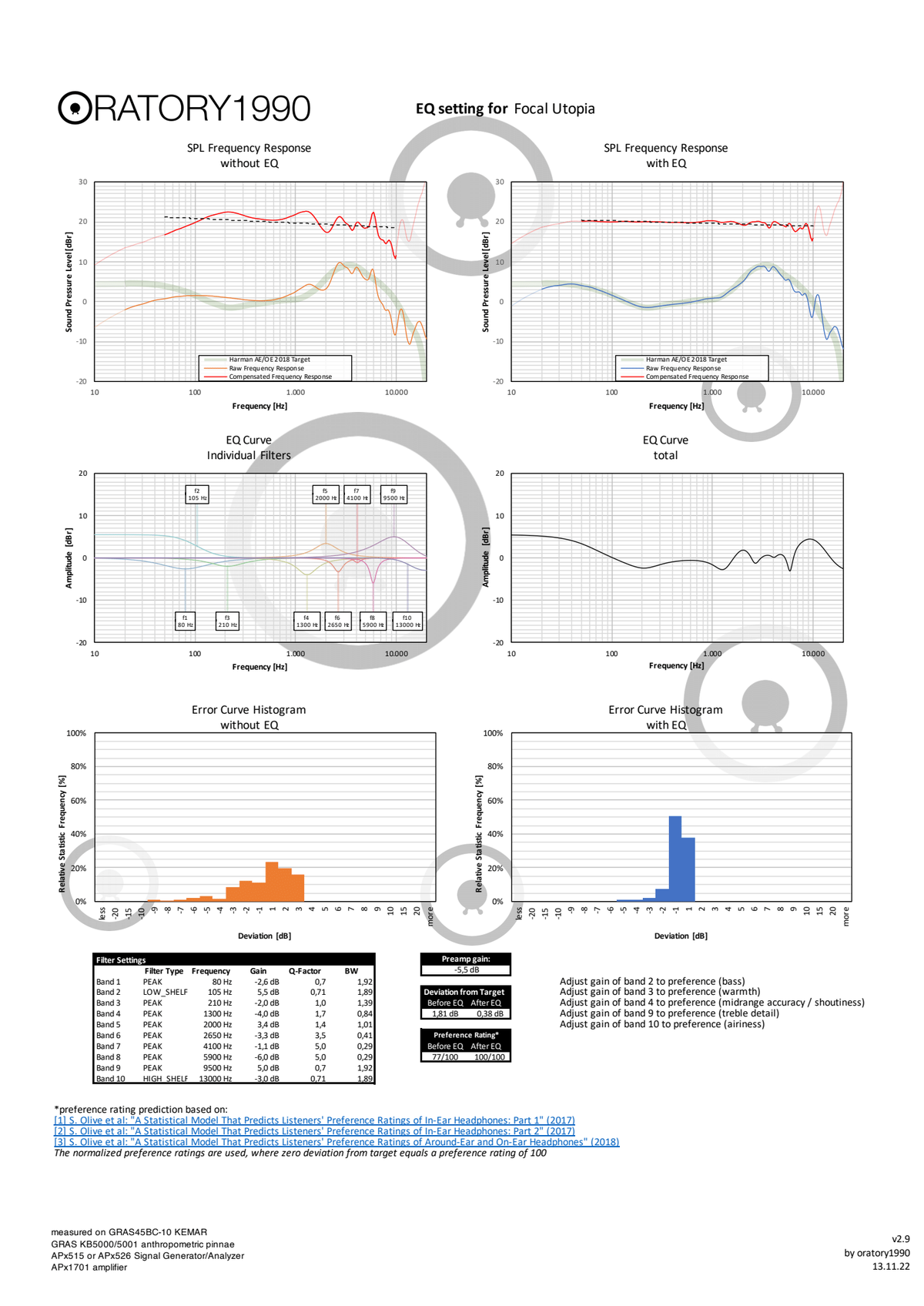With tiny special mics inserted in your ear channels.
Do any of the commercial options out there come with a calibration curve?
With tiny special mics inserted in your ear channels.
This way you would get the free field (FF) compensation curve which was used in the early days but sounds too bright as we don't listen usually to only direct sound. The other extreme is to place loudspeaker(s) in a highly reflective room (for example reverberation chamber) and they you get the difuse field compensation curve which is also though not realistic as normal rooms are somewhere in between and there comes the Harman approach. Additionally the compensation curve changes according to the angle of incidence and used ears/head/torso which is also usually different to the one of individual humans...(good chance I have a way oversimplified idea)
If you put a flat measuring (on a microphone) loudspeaker into an anechoic chamber and measure it using a dummy head&torso rig, don't you get its compensation (neutral target) curve just like that?
In the end more accurate will be the one that matches the ear geometry and HRTF of an individual human and this already shows its limitation, for exampe rig A might be closer to human C and rig B to human D. For general use though like making generic corrections I would chose the one that is closer to the average of the human population.Stupid Question, how do we know that the B&K is inaccurate while the GRAS is more accurate instead of the other way around?
I mean is there like a 'reference' headphone out there that we're absolutely certain matches the Harman Target that we can use to weed out the bad measurement rigs?
A given calibration is unfortunately not enough as in the end its behaviour will depend also on the ear channel geometry and placement, so best is to calibrate it in your own ear using a known linear source like a loudspeaker.Do any of the commercial options out there come with a calibration curve?
A given calibration is unfortunately not enough as in the end its behaviour will depend also on the ear channel geometry and placement, so best is to calibrate it in your own ear using a known linear source like a loudspeaker.
A free field calibration could be done also above the modal region by windowing the measurements but the question is also would you really want a free field compensation?my neighborhood doesn't have an anechoic chamberand i don't think it would be much of a calibration without it even with a linear source.
Well, how do you measure that? Would be naive to suggest putting microphones in a bunch of human ears?

In the same way that we strive to create room independent loudspeakers, should we be trying to create cheek independent headphones?

If noone else has a 9k peak, the reasonable assumption to me would be that your ears create that peak since your case is the odd one out.I am not sure how nobody so far didn't notice that 9khz peak, it sounds just horrible to me, also dunno why it doesn't show up in Amir's measurements, but that peak is noticeable in the other measurement to some degree.
To me the headphone sounded just horrible, not sure why many claim it to be the "world's best closed headphone". a complete letdown soundwise.
the peak is visible in the other measurement posted by Mr. Olive.If noone else has a 9k peak, the reasonable assumption to me would be that your ears create that peak since your case is the odd one out.
It would be helpful if you provide links to the "other measurements" you are referring to so we can get a more complete understanding on how you reached the conclusion that the 9k peak may be inherent to the headphone rather than your ears.
"Inaccurate" would be depend on the purpose you are using the system for. Since Harman research was conducted on specific fixtures the target curve does not necessarily translate well to a fixture that is different.Stupid Question, how do we know that the B&K is inaccurate while the GRAS is more accurate instead of the other way around?
I mean is there like a 'reference' headphone out there that we're absolutely certain matches the Harman Target that we can use to weed out the bad measurement rigs?
Do any of the commercial options out there come with a calibration curve?

He probably wanted to make a point only measurements done with calibrated fixtures adhering to certain standards tell the truth.Jude Presentation
I was very surprised and disappointed in most of this presentation. Bulk of time was spent showing and ridiculing the DIY measurement rigs members of his own forum had created. He showed pictures of them and while correctly stating some issues with them, I just could not figure out what he is after.
Yes, great point. There are many folks measuring these days but mostly the mainstream headphones. The more obscure one, understandably, not so much.Hobbyist are creating these measurements because headphone companies are not providing them. If Jude wanted to improve things, he should have complained about lack of such measurements from that sector which would be likely to be in this conference, than DIY people.
Fortunately the second half of the talk was better in that he showed a bit about how they measure headphones which seems to be following what Tyll did with use of square wave and such. I am personally not a fan of driving headphone or speakers with square wave, especially a low frequency one. This can be hard on the transducer with the long duty cycle essentially being DC. I saw little justification for this method other than a hack to show the frequency response, sort of, using crude FFT.
The other thing he mentioned is that they no longer calibrate at one frequency and instead use white noise. I don't understand the merit of this either as matching the measurements to target needs to be done in a way that relates to the research. Credit to him he asked for feedback from audience but none was provided. Target matching is a visual thing for humans anyway so ultimately it doesn't matter per se.
I have to say.. the best headphone I ever heard was HE-1 (caveat: approx. 15 mins for what that's worth with 'demo' music). Also heard a few other ones that could kind of compete on certain aspects and haven't heard some TOTL headphones that I may like even more.In QA section he was asked what his favorite headphone was. He said the Sennheiser HE-1 ($45,000). He was asked if he had measured it. Shockingly he said no! Gosh that was awkward when you are in a measurement seminar and you don't believe in this stuff to practice it.
Dr. Olive Presentation
They developed a compensation curve for 5128 relative to Harman target but alas, not all headphones showed the same differential. Using this new target, the above headphone showed an error of I think 6 points. But there are others that cannot be fixed this way.
After comparing a couple of measurementsthe peak is visible in the other measurement posted by Mr. Olive.
Could be my ear too who knows, but HD600, DT770 etc sound all normal to me, comform well with others' measurements when measured with my ears.
Important to note that the GRAS rig is supposed to have a 9-10khz dip, and that is an effect of the artifical ears used. If something measures without a dip around that frequency on a 43AG that most likely means it is too bright. If you look at 43AG measurements you'll find that a whole lot (most?) of them show that exact same high-Q dip.But that is due to your own ears and mic compensation, for example on Oratory both the Elex and Utopia show a dip around 9 kHz


and its logical that if those measure neutral there for you the Stealth will have a peak there.
Good call, me too.I already stopped visiting headfi after Jude ban NwAvGuy.
It could be that too, so I think it's fair to assume both ways rather than thinking so one-sided like "he says it cuz $$$$" or "he says it cuz HE1 is obviously the best" because we can't truly know what a person really thinks.I think it’s more likely Jude named the HE1 as his favourite headphone as they are not realistically in competition with any of his sponsors. They are a safe bet to keep the sponsors happy.
That's exactly how I would do it. That's how Todd Welti did it in his previous study. The 2nd picture shows the FR of 10 headphones (rows) on eight subjects (columns) measured with a microphone measured at the blocked entrance of the ear canal. compared to measurements made on on a flat plate (no pinna) and the GRAS45CA with the old pinna prior to the anthropomorphic pinna.Well, how do you measure that? Would be naive to suggest putting microphones in a bunch of human ears?
In the same way that we strive to create room independent loudspeakers, should we be trying to create cheek independent headphones?
Perhaps a good consumer test of a headphone should include different cheek shapes. Ergonomics are huge in headphone quality and cannot be separated from audio quality.
I think we need to think big if we ever want to have meaningful reviews of headphones.How difficult would it be to develop test procedures and fixtures intended at calibrating an empirical (mathematical) model of the headphone instead of characterizing its response on a particular test fixture? The model could be used to correlate and predict responses on GRAS, BK, or even an individual HRTF. The ‘targets FR’ would become ‘target models’ correlated to represent specific populations groups.
Too complex? Dream only?
